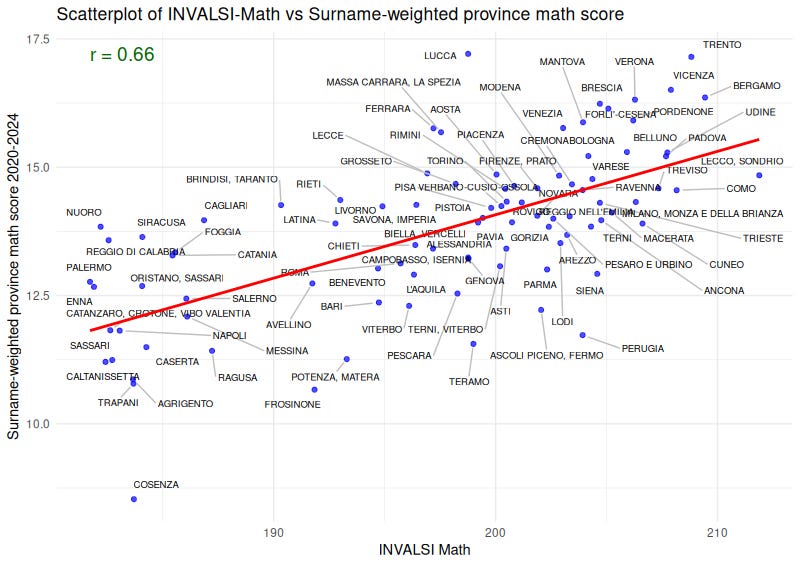Italy’s Hidden Math Genius Hotspots: What Surnames Reveal About Elite Talent
How ancestral geography predicts Math Olympiad success—even more than today’s wealth
You've seen Italy's famous north-south divide in education (and so much else). Now we reveal where mathematical excellence truly thrives—and why your surname might hint at your chances of becoming the next Enrico Bombieri (Italy's Fields Medal-winning mathematician).
The Shockingly Strong Pattern
Our analysis (paper is under review) of 1,509 Math Olympiad winners (2020-2024) reveals:
r = 0.57 correlation with provincial math scores (Italy's national standardized tests given to all students).
r = 0.66 when weighted by surname ancestry (p < 0.001)
Latitude matters 2X more than GDP (β = 0.67 vs. 0.31)
How We Calculate Surname's Ancestral Home
Think of surnames like pasta dishes - some are hyper-local (only found in one town), while others are nationwide. We measure this using TF-IDF, a method borrowed from search engines.
Step 1: Count Surname Appearances
Example: The surname "Rossi" appears:
1,000 times in Milan (Province A)
100 times in Naples (Province B)
10 times in Palermo (Province C)
Step 2: Calculate "Localness" (TF)
Term Frequency = % of people in a province with that surname
Milan: 1,000 Rossi / 1,000,000 people = 0.1%
Naples: 100 Rossi / 500,000 people = 0.02%
Palermo: 10 Rossi / 300,000 people = 0.003%
Step 3: Measure Rarity (IDF)
Inverse Document Frequency = log(Total provinces / Provinces with the surname)
Rossi appears in 3/100 provinces → IDF = log(100/3) ≈ 3.5
Bortolussi (a rare Venetian name) appears in 1/100 → IDF = log(100/1) = 4.6
Step 4: Combine for "Home Score" (TF-IDF)
Rossi in Milan: 0.1% (TF) × 3.5 (IDF) = 0.35
Bortolussi in Venice: 0.5% × 4.6 = 2.3 (higher score = stronger local tie)
Step 5: Convert to Probabilities
For Rossi:
Province TF-IDF Score Probability Milan 0.35/(0.35+0.07+0.01) ≈ 81%. Naples= 0.07≈ 16%; Palermo=0.01≈ 3%.
Interpretation: An average Rossi has 81% chance of ancestral roots in Milan vs. 3% in Palermo.
Real-World Examples
"Esposito" (Naples)
TF-IDF peaks in Campania → 92% probability
(Historically given to orphans in Naples)
"Baggio" (Veneto)
88% probability in Vicenza
"Lo Presti" (Sicily)
95% in Messina
Why This Matters for Math Talent
When a Lo Presti wins a Math Olympiad:
We credit 95% of their score to Messina's ancestral pool
Only 5% to their current province (e.g., if they moved to Turin)
Why This Matters
Nature vs. Nurture: Disentangling Ancestry from Opportunity
Raw Scores Reflect Today's Inequalities
Potentially affected by school quality, family resources, and regional funding
Example: A gifted student in a poorly-funded southern school may underperform
Surname-Weighted Scores Reveal Deeper Patterns
Track mathematical aptitude by ancestral origin rather than current address
Example: A Milanese student with Sicilian surnames shows southern Italy's genetic-cultural legacy
Controls for modern advantages by focusing on where families originated
Key Insight: When surname-weighted scores remain strong after accounting for wealth, it suggests innate regional differences in mathematical ability.
The Latitude Effect:
β = 0.67 for surname-weighted scores vs. 0.50 for raw scores
Suggests surnames track ancestral origin, as latitude is a proxy for northern genetic ancestry.
Policy Paradox:
GDP is correlated to scores today (β = 0.31)
But can’t erase 800 years of regional divergence (hint: DNA).
Want to explore Italy's educational hotspots?
Paid subscribers unlock:
🔍 Interactive province-level maps of INVALSI math and Italian scores
🏙️ Municipality-level data revealing hyperlocal patterns (but much more noisy).



